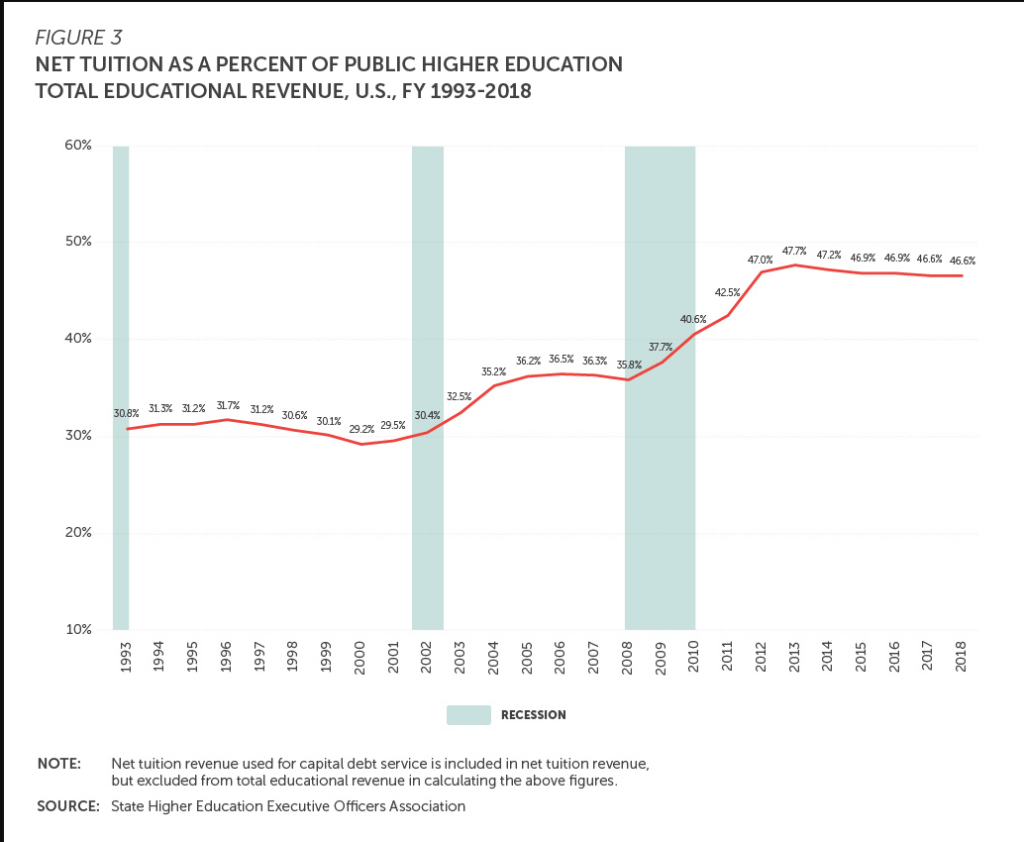University enrollment has annually grown, despite four digit percent increases in the costs of college over the last three decades, seemingly making an inelastic demand for college eduation. Yet, for the 2020-21 school year, for the first time, there may be a a shift in the supply/demand equation given the changes in the recruitment for the newest class of students, where accepted students have greater leverage than the university in the enrollment process.
Colleges that are used to dangling coveted acceptances in front of high school students and their parents are instead having to provide flexibility [in enrollment for newly admitted students] in a way that was once unheard of for selective schools.
The New York Times, May 1, 2020
As we discussed just yesterday, students may not be enrolling at universities at the same rate as they would in a typical application cycle, so admissions officers are reacting in an unorthodox way: offering qualified waitlist candidates admissions in advance of the May 1 traditional enrollment deadline, and well in advance of the second, extended due to COVID-19 disruptions, enrollment deadline of June 1.
As one student recently shared with The New York Times:
Ahead of the traditional May 1 deadline to decide where she would go to college, Tiffany Tang had four schools to choose from. Then on Tuesday, the University of California, Los Angeles emailed to offer her a spot off the wait list. That evening, she received a call from a Houston area code — an admissions officer from Rice. On Wednesday, Cornell got in touch.
May 1, 2020
Anecdotally, high school seniors we counsel have also received earlier-than-usual offers of admisisons off the waitlist from: Texas Christian University, Southern Methodist University, Chapman University Dodge College of Film & Media Arts, and the University of Notre Dame.
At Cornell, admissions officers took 99 students off the wait list last week and extended them offers, said Jonathan Burdick, the school’s vice provost for enrollment. That is a fairly typical number, he said, but the university would usually wait until after May 1 to make that move.
“We knew we would almost certainly be going to the wait list after today,” Mr. Burdick said on Friday. “So we decided to do it early.”
The New York Times, May 1, 2020
Additionally, some universities have extended their enrollment deadline in this last week before May 1, like San Jose State University in California to June 1, possibly attempting to merit greater enrollment numbers for the 2020-21 school year. While others are offering incentives, like priority enrollment or additional merit scholarships, to entice students to enroll:
“The gloves have come off,” said Angel Pérez, vice president for enrollment and student success at Trinity College in Connecticut. He laments this trend. “You’re talking about a scenario where colleges need to enroll students at any cost.”
The Washington Post, April 23, 2020
Furthermore, maintaining the enrollment of continuing college students is also a concern for many university adminstrators. Students are dismayed about distance learning and the mandated truncating of their college experience for the last two and half to three months of the 2019-20 school year, as well as the prospect of continuing the distance learning model in the fall term of the 2020-21 school year. Many students share with me that they are considering gap semesters and waiting to re-enroll until spring terms or transferring colleges closer to home at less cost, if they’re going to have to take classes online anyways, a sentiment echoed by incoming first year students:
“It doesn’t make sense to pay 20 grand to sit at my computer at home and take online courses,” he said. “You can get the same education from a community college.”
Johnny Kennevan, graduating senior, The New York Times, May 1, 2020
For those university administrators hoping to enroll a greater number of international students in attempting to fill any gaps in total enrollment brought about by lessening demand from domestic students. International students who are ineligible for financial thus pay full tuition rates, have been in recent years a way for universities to boost their revenue and any reduction in demand from this segment of the univesity population could affect the univeristy fiscal health and that may be what is developing.
…they [universites] expect fewer foreign students on campus in the fall. Last month, the American Council on Education, a trade group, projected that international enrollment would drop by 25 percent.
“Everything I’ve heard from the universities is that they’re forecasting, at best, no new incoming international students,” said Daniel Hurley, chief of the Michigan Association of State Universities, which represents the state’s 15 public universities. “That’s not just a one-year hit, that’s a four-year hit. Those students would typically be enrolled for four years, so that’s a negative on the balance sheet for several years.”
The New York Times, May 1, 2020
With the cancellation of SAT’s and ACT’s in international countries last winter and through the spring, given the COVID-19 outbreaks, plus recent changes to students obtaining visas to study in the United States, international students may not be able to enroll in U.S. universities starting in the fall.
China has remained the largest source of international students for the US in the past decade, with 369,548 Chinese students enrolled in US higher education programmes in 2018, more than three times the count from nine years earlier, according to the Institute of International Education. The group together contributed US$15 billion in tuition payments.
South China Post, April 24, 2020
So although students and families may benefit in the short run from university policies to increase enrollment, the fiscal situation for most universities will be taxed to varying degrees over the next 12-18 months, with wide-ranging implications for all stakeholders.
With lower-than-expected student enrollment numbers, university administrators are losing an essential revenue source. Tuition accounts for nearly 50% of public universities total revenue, according to the most recent figures compiled by the State Higher Education Executive Officers Association, and for private non-profit universities tuition is the largest primary source of revenue at 30%, according to the most recent statistics calculated by the National Center for Education Statistics.

Although brand name universities with strong endowments may be able to survive the current economic upheaval, related to the COVID-19 health crisis, other universities’ balance sheets may not create as much resiliency for the institution. And, for a third group of universities, where administrators were already considering closures, mergers with other colleges, or other drastic changes to university operations, before the COVID-19 health emergency, may be teetering even more on the brink of non-existence.
The coronavirus pandemic hit at a time when American higher education, which employs about three million people nationwide, was already suffering from a host of financial problems. Many liberal arts colleges have struggled to meet enrollment goals in recent years because of rising tuition costs, concerns about student debt and a shrinking population of young people.
Since mid-March, when colleges abruptly shut down campus operations and moved to online learning, schools have announced hundreds of millions of dollars in losses and say that a $14 billion federal aid package will not be nearly enough to keep struggling schools afloat. Executives have taken pay cuts, endowments have shrunk, hiring has been frozen and construction projects have stopped.
But experts say that is only the beginning if schools cannot persuade students to return in the fall, when many campuses are bracing for the possibility that online learning could continue.
The New York Times, May 1, 2020
Furthermore,
As they absorb signs of declining enrollment, colleges are preparing for more revenue losses and spending cuts. Like many schools, the University of California, San Diego has already paused three construction projects and imposed a partial hiring freeze.
“We’ve promised no layoffs until June 30,” said Pradeep Khosla, the chancellor. But the real impact of the virus could be felt at the end of September, when the university’s fall term begins and students must put down tuition money, rather than just deposits.
“That’s when the rubber will meet the road,” he said.
The New York Times, May 1, 2020
For public universities, like University of California San Diego, administrators may experience compounding declines in revenue, as state subsidies to public universities may be reduced as well, as the California State Legislative Analyst’s Office recently forecasted a $35 Billion net fiscal decline in state revenues.
And, for a public university system, like the University of California where the President Janet Napolitano recently announced a fiscal deficit of $558 million for the month of March 2020 alone, the double declines in tuition and state subsidies may affect the overall quality of education, and families may also be bileld for increased tuition to cover the revenue shortfalls.
When there’s shifts in the supply/demand equation, there’s seemingly benefits to those that demand over those who supply. In the case of colleges, students and families may, in the short run and for the first time in generations, have the opportunity to be in a better negotiating position at least through the 2020-21 school year. Unfortunately, though, the economic shock and its subsequent impact on the fiscal health of universities may have long-ranging consequences that could quickly overcome the gains that students and families may experience in the shortrun. What is for sure though to quote Bob Dylan, “I feel a change comin’ on.“
Since 2003, Jill has advised clients about all aspects of the educational experience, no matter the level of complexity. A UCSD and Harvard graduate, as well as a former high school teacher, Jill works tirelessly so clients succeed. Contact her at [email protected] for more details about how her expertise can benefit families and organizations.



